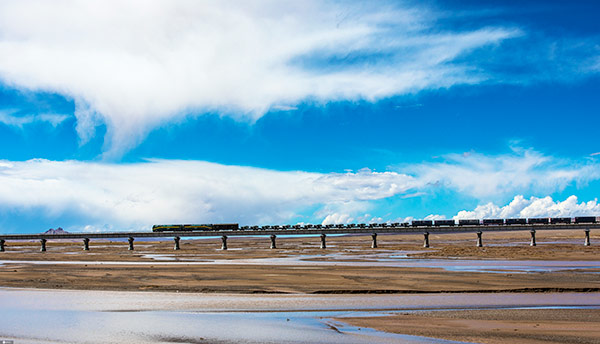Plateau rail line is generational affair for family
Updated: 2021-08-04 (Xinhua)
 Print
Print





China's Qinghai-Tibet Railway-the world's highest and longest plateau railroad. [Photo/IC]
Armed police officer Luo Changqiang says he cannot remember how many times he had watched trains roaring past the tunnel of the Kunlun Mountains.
Over the past 11 years, Luo, 30, has been serving in an armed police squad in Northwest China's Qinghai province, responsible for ensuring the safe passage of trains at the 1,686-meter-long tunnel.
The tunnel is the world's longest on a plateau underlain by permafrost and also a crucial mountain pass along China's Qinghai-Tibet Railway-the world's highest and longest plateau railroad.
The railway, the first connecting the Tibet autonomous region with the rest of China, has stimulated the development of the plateau region by bringing tourists, materials, and business opportunities.
Located in Hoh Xil in the hinterland of the Qinghai-Tibet Plateau, one sentry post of Luo's squad is built at an altitude of 4,868 meters. It is the highest-altitude stationary sentry post of the armed police force, and thus is called the "post in the clouds".
The average temperature at the post is-10 C, and the lowest temperature in winter can reach down to-40 C.
Encouraged by his father and grandfather who had once devoted themselves to the highland, Luo says he has been dreaming of coming here, despite the harsh environment and extreme weather.
Luo's grandfather was a road mender who participated in the renovation of the Qinghai-Tibet highway between 1964 and 1974.
At that time, the materials for the repair had to be carried on workers' shoulders, Luo says, adding that many workers died due to high altitude and poor medical conditions.
Luo says it took half a month for his grandfather to walk from Xining to the Tanggula Mountains, where he paved roads. "My grandfather couldn't explain the significance, but he believed that the road must be built."
Such faith passed down to Luo's father, who came to build the railway section linking Golmud in Qinghai and Lhasa in Tibet, in 2002.
Luo's father said that he had witnessed fellow workers faint from the lack of oxygen and fall from bridge piers.
But the rough working environment did not stop Luo's father, nor Luo himself.
The railway section connecting Golmud and Lhasa finally went into operation in July 2006, marking the opening of the Qinghai-Tibet Railway.
On the same day, the squad that Luo later served began standing guard. Luo joined the squad in 2010.
In the past 15 years, the team has trekked more than 180,000 kilometers on patrol and guaranteed the safe passage of over 150,000 trains.
They have also offered help to local residents as well as tourists, and cleared hazards along the railway.
Their efforts not only ensure the safety of the plateau rail link but also propel the development of Tibet.
The story of Luo's family touched other armed police officers of the squad when his father and grandfather came to visit him in 2015.
"I want to continue the missions that my father and grandfather embarked on," Luo says.








